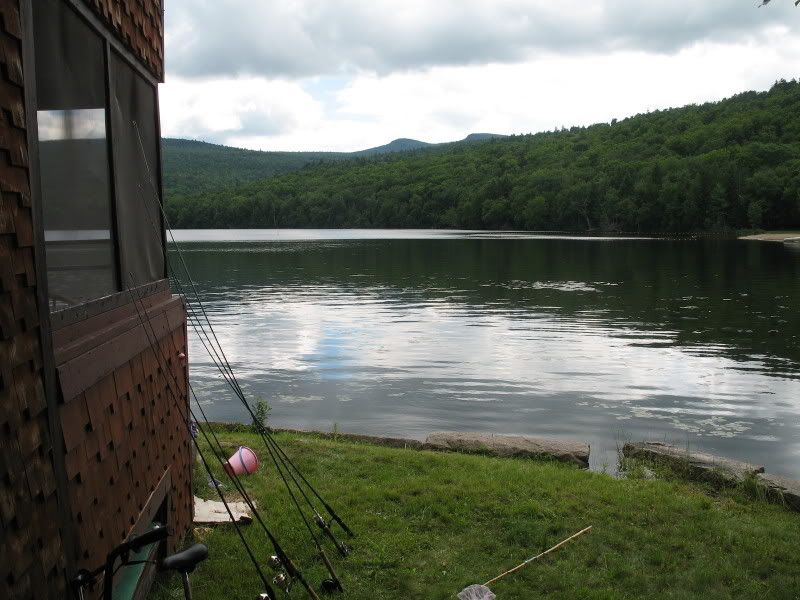|
|
Post by jskowron on Aug 13, 2008 17:25:34 GMT -5
What are these mayflies? There were dozens of them on the screens of our camp, hatching during the first sunny and warmer day in a week. They were about a size 16-18, black body and eyes, three white tails, almost a zebra patterning on their legs. Here's one on my thumb-  Here's one next to it's skin on the screen-  The bugs and skins were located on the screen between 6-10 feet off the ground. The camp is about 5-10 feet from the pond (distance shown in the picture below- the screen can be seen above the poles/rods on the left). I think it is pretty cool that the nymph climb out of the water, over the granite retaining wall, across the grass, an up the side of the camp to the screens. The screens are also covered with quite a few dragonfly nymph skins, and I find them on the upstairs windows 20 feet up.  |
|
|
|
Post by Mark Patenaude on Aug 22, 2008 8:44:36 GMT -5
Trico
|
|
|
|
Post by jskowron on Aug 22, 2008 11:53:16 GMT -5
Mark,
I thought tricos too, but these have a little hindwing, which tricos do not have. It's not really important what they are specifically from a fishing perspective, it's more out of curiosity as they are "almost" like a few different types of common mayflies, except for a little difference (e.g. like tricos, but with a hindwing, like a BWO[procleon] but with 3 tails). All of the online mayfly ID sites I consulted where you enter specific attributes (e.g. size, number of tails, appearance of front legs, size of hindwing) have come up as dead ends.
Jeff
|
|
|
|
Post by jlibs on Aug 22, 2008 15:52:39 GMT -5
Jeff, Terrific photos and great post coming from a guy who only uses elk hair caddis as a dry, emerger, wet, nymph, etc. with the same size 14 and pattern? Is this post just for show?
JLIBS
|
|
|
|
Post by jskowron on Aug 22, 2008 23:23:02 GMT -5
Josh- now that you bring it up, these mayflies would be perfectly imitated by a size 14 EHC. I'll give it a try next year.
|
|
|
|
Post by Mark Patenaude on Aug 25, 2008 7:49:46 GMT -5
Baetis.
Sorry didn't see the little hind wing. Too much computer work and it tasks the eyes.
There are literally dozens of different sub-species of Baetis' and the color ranges from very light olive to very dark olive that looks almost black, depending on the geographic region and water color/bottom composition.
|
|
|
|
Post by jskowron on Aug 25, 2008 9:07:14 GMT -5
Mark- The mystery continues- Baetis only have 2 tails (according to www.hatchesmagazine.com/page/january2006/86). Baetisca have 3 tails and a large hindwing. This one has 3 tails and a minute hindwing. It is likely some local variation of something. |
|
|
|
Post by Mark Patenaude on Aug 27, 2008 7:55:31 GMT -5
Its an Attenella Attenuata or...
a Small Eastern BWO or Slate Wing Olive. Here are the descriptions for the Dun and Spinner.
I was a little more detailed here...
Dun minimum length: 6 mm.
Dun maximum length: 8 mm.
Dun identification keys:
Dun body description: bright olive freshly emerged, medium to grayish olive after several seconds, and blackish olive after several hours
Dun wings: pale gray freshly emerged, gray after several seconds, and dar gray to black after several hours
Dun legs: light olive freshly emereged, olive after several hours
Dun tails: 3, grayish olive freshly emerged, dark grayish olive after several hours
Spinner minimum length: 6 mm.
Spinner maximum length: 8 mm.
Spinner identification keys: (male) claspers whitish, light brown at base, w/2 joints, apical segments 6x as long as broad, penes broadened more at apex than at base
Spinner body description: thorax dark brownish to blackish olive, abdomen medium to rusty olive brown to dark olive brown
Spinner wings: hyaline, fore wing with detached intercalary veins, hind wing w/costal angulationSpinner legs: light olive
Spinner tails: 3, white to light olive to tannish gray
|
|